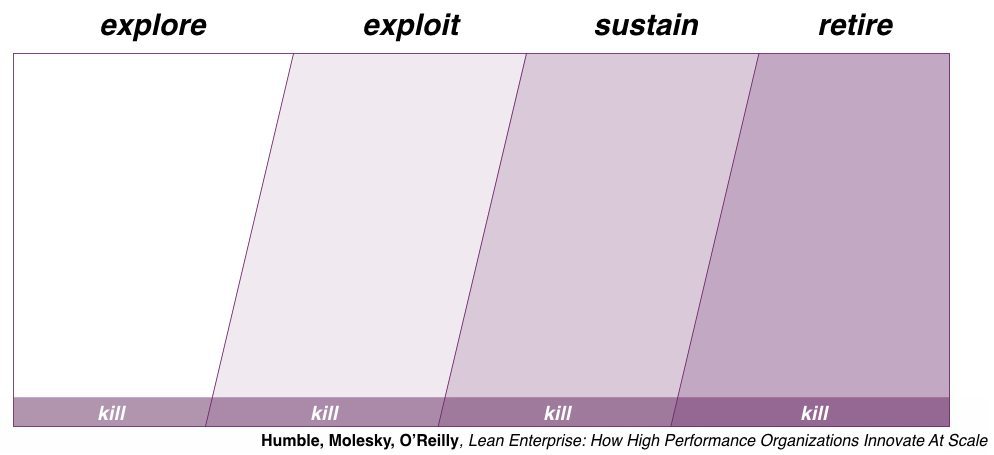In this talk I share the key issues holding organizations back from unleashing innovation, and explain three areas to consider when aligning your organizational vision, strategy and product portfolio to achieve high performance at scale.
Innovation Portfolio Management
One of the first exercises I run with executive teams is mapping their business portfolio in order to visualize current work in progress and how it aligns to the overall business strategy. Without exception, every time we run this exercise the gap between the current and desired state is far wider than any executive believed, hoped or even imagined.
Innovation portfolio mapping requires taking an end-to-end lifecycle view of the initiatives in your organization. Lean Enterprises consider four main domains:
- Explore early stage initiatives as bets for the future with high degrees of uncertainty.
- Exploit initiatives that have achieved product-market fit and the organization wants to grow and scale.
- Sustain initiatives that have become repeatable and scalable business models, products or services that can drive the majority of revenue for the organization.
- Retire initiatives that are long lived or potentially no longer beneficial (even constraining) to the organization’s future success.

High performance organizations focus on building capability to continuously move initiatives through these domains. They understand that using a one-size-fits-all approach to strategy, practices and processes across the entire portfolio will result in negative outcomes and results.
Alignment At Scale
Clarity of purpose and mission is critical to achieve alignment at scale. Leaders must let go of dated command-and-control methodologies and mindsets, and replacing them with intent-based leadership. The foundation of intent-based leadership is based on the Army’s philosophy of command of Mission Command; it is the exercise of authority and direction by the commander using mission orders to enable and empower agile and adaptive leaders in the field. The key information provided by leadership that describes the outcome of the mission to be achieved is the Principle of Mission. How well the Principle of Mission is communicated and understood allows individuals to use judgment and initiative to act decisively in the absence of detailed orders from leaders.
High performance organizations understand that clearly articulated purpose provides context for the outcomes to be achieved. The role of leaders communicate why this mission matters and what a successful outcome would be, then trust the individuals closest to the work figure out how to get there. This is the basis of Mission Command, an alternative to command-and-control in order to create alignment at scale, and push decision-making to the front line of the organization.

Running Programs At Scale
While there are several frameworks for running large-scale Agile programs, the most popular suffer from one major flaw: they take Agile teams and embed them in a traditional program management paradigm, one that is ultimately derived from the 19th-century management ideas on how to divide labor between managers and workers.
Lean Enterprises embrace the principles purpose, experimentation and learning behind the Lean/Agile paradigm and truly leverage the inventiveness and passion of people throughout your organization. Here I illustrate with examples of how organizations have applied these principles successfully even in complex, regulated domains.
I show how to use use hypothesis-driven development to apply scientific rigor and experimentation to large programs of work resulting in better outcomes for all.

